CHEM10007 Lecture Notes - Lecture 6: Valence Electron, Lone Pair, Electron Configuration

LECTURE 6
COVALENT BONDING, MOLECULAR LATTICES & SHAPES
OF MOLECULES
COVALENT BONDING
•More than 90% of things are made of covalently bonded stuff.
•Hair, plastic, stuff in air, coating on the whiteboard
•In the simplest version, a hydrogen atom (1 electron) and another hydrogen atom come together
and share their pair of electrons, which is redrawn as a bond. (H + H = H-H diagram)
TWO TYPES OF COVALENT SUBSTANCES
•1. Molecules
•The molecule has strong bonds between the atoms in the molecule, which are stronger than
the forces between one molecule and another.
•An example of a covalent molecule is oxygen; two O atoms bond together and make a pair.
•2. Covalent network
•Atoms are held together by covalent bonds, forming a lattice.
TYPICAL COVALENT SUBSTANCES
•Molecules
•Covalent networks
COVALENT MOLECULAR SUBSTANCES
•Very few of these conduct electricity because the forces that attract a molecule to another
molecule are weak, so solids aren’t formed easily as the particles are far apart and not very well
attracted to each other.
•To conduct electricity, you need charged particles that can move, which is almost always not the
case for covalent molecular substances.
IONIC COMPOUNDS
PHYSICAL PROPERTIES OF IONIC COMPOUNDS
•(table)
ELECTRON DOT DIAGRAMS
•Are done to represent the valence electrons in a substance.
•Everything in group 1 has 1 valence electron drawn in, everything in group 17 has 7 valence
electrons drawn in.
DRAWING COVALENT BONDS
LEWIS STRUCTURES
•Electrons are shared to form bonds between atoms, to give the atoms a noble gas like electron
configuration.
•(Cl + Cl diagram)
•This is called an octet, it is said the atoms in the molecule have ‘satisfied their octet’.
DRAWING MOLECULES
•(diagrams with dots)
•Non bonding electrons - a lone pair.
•A pair of electrons that don’t bond.
•A pair of bonding electrons can also be represented as a line.
DRAWING LEWIS STRUCTURES
Document Summary
Molecules: the molecule has strong bonds between the atoms in the molecule, which are stronger than the forces between one molecule and another, an example of a covalent molecule is oxygen; two o atoms bond together and make a pair, 2. Covalent network: atoms are held together by covalent bonds, forming a lattice. Electron dot diagrams: are done to represent the valence electrons in a substance, everything in group 1 has 1 valence electron drawn in, everything in group 17 has 7 valence electrons drawn in. Lewis structures: electrons are shared to form bonds between atoms, to give the atoms a noble gas like electron configuration, (cl + cl diagram, this is called an octet, it is said the atoms in the molecule have satisfied their octet". Drawing molecules: (diagrams with dots, non bonding electrons - a lone pair, a pair of electrons that don"t bond, a pair of bonding electrons can also be represented as a line.




